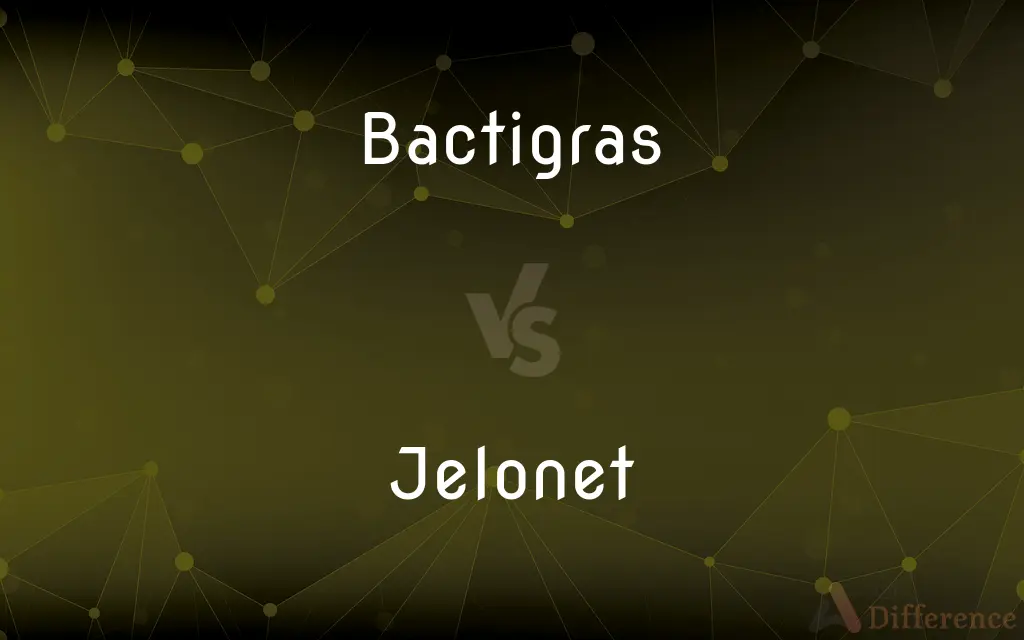Bactigras vs. Jelonet — What's the Difference?
By Fiza Rafique & Maham Liaqat — Published on February 28, 2024
Bactigras is an antiseptic paraffin gauze dressing for wound care, impregnated with chlorhexidine, while Jelonet is a neutral paraffin gauze dressing, ideal for minor burns and wounds.

Difference Between Bactigras and Jelonet
Table of Contents
ADVERTISEMENT
Key Differences
Bactigras contains chlorhexidine, an antiseptic that helps prevent wound infections, making it suitable for wounds at risk of infection. Jelonet, however, is designed to protect the wound without any antiseptic properties, making it a choice for sensitive skin or when infection is not a primary concern.
Bactigras's antiseptic property is beneficial for wounds that require a barrier against bacteria. Its use is particularly advantageous in clinical settings or for wounds in dirty environments. Jelonet, being neutral, is preferred for its gentleness and is often used for less contaminated wounds or when managing burns.
The choice between Bactigras and Jelonet depends on the wound's condition and the desired outcome. Bactigras is aimed at preventing infection in moderate to high-risk wounds, while Jelonet is best for creating a moist healing environment with minimal infection risk.
Bactigras is recommended for use under medical supervision, especially in wounds that are deep or heavily contaminated. Jelonet’s neutral nature makes it a safe first-aid choice for home use, particularly for minor burns and abrasions where infection control is not the immediate concern.
The cost and availability of these products can also influence choice. Bactigras, with its specialized antiseptic formulation, may be more expensive than Jelonet. Users should consider both the wound care needs and budget when selecting between these dressings.
ADVERTISEMENT
Comparison Chart
Composition
Paraffin gauze with chlorhexidine
Plain paraffin gauze
Antiseptic Property
Yes
No
Ideal Use
Wounds at risk of infection
Minor burns and wounds
Skin Sensitivity
Less suitable for very sensitive skin
More suitable for sensitive skin
Cost
Generally higher due to antiseptic component
Lower, due to lack of antiseptic component
Compare with Definitions
Bactigras
Suitable for high-risk wounds.
For the contaminated cut, Bactigras was the best option.
Jelonet
Neutral paraffin gauze dressing.
Jelonet was applied to the minor burn for protection.
Bactigras
Used under medical supervision.
The doctor recommended Bactigras for the patient's burn.
Jelonet
No antiseptic properties.
Jelonet, lacking antiseptic properties, was used with a separate antibiotic cream.
Bactigras
Impregnated with chlorhexidine.
The nurse chose Bactigras for its chlorhexidine to combat bacteria.
Jelonet
Gentle on sensitive skin.
Jelonet was chosen for its gentleness on his sensitive skin.
Bactigras
Prevents wound infection.
Bactigras helped in keeping the wound clean and free from infection.
Jelonet
Ideal for minor burns and wounds.
For her scraped knee, a Jelonet dressing was used.
Bactigras
Antiseptic paraffin dressing.
Bactigras was applied to prevent infection in the surgical wound.
Jelonet
Creates moist healing environment.
Jelonet helped maintain a moist environment for the wound to heal.
Common Curiosities
Is Bactigras suitable for sensitive skin?
It can be used on sensitive skin, but care should be taken due to its antiseptic component.
Can Bactigras be used without a prescription?
While it can be bought over the counter, it's best used under medical advice, especially for serious wounds.
What is Bactigras used for?
Bactigras is used for dressing wounds at risk of infection, providing antiseptic protection.
How often should Jelonet be changed?
Jelonet should be changed according to the wound's condition, usually every 24 to 48 hours.
Is Jelonet good for burns?
Yes, Jelonet is ideal for treating minor burns, providing a protective and moist healing environment.
Does Bactigras help heal wounds faster?
Bactigras can expedite healing by preventing infection, but healing time varies by wound type and care.
Can I cut Jelonet to fit my wound?
Yes, Jelonet can be cut to size to fit the wound area perfectly.
How does Bactigras prevent infection?
The chlorhexidine in Bactigras acts as an antiseptic, killing or inhibiting the growth of bacteria.
Is Bactigras more expensive than Jelonet?
Generally, yes, due to its antiseptic properties.
Can Jelonet cause skin irritation?
It's less likely to cause irritation due to its neutral composition, making it suitable for sensitive skin.
Can Jelonet be used on all types of wounds?
Jelonet is best used on minor burns and wounds, not recommended for heavily infected wounds.
Is Jelonet absorbent?
Jelonet itself is not highly absorbent; it's designed to allow the wound to drain freely.
Is there anyone who shouldn't use Bactigras?
Individuals with chlorhexidine sensitivity should avoid using Bactigras.
Can Bactigras be used for animal wounds?
Yes, but it's advised to consult a veterinarian for proper guidance.
What are the storage requirements for Jelonet?
Store in a cool, dry place, away from direct sunlight and heat.
Share Your Discovery

Previous Comparison
Google Maps vs. Sygic
Next Comparison
BET vs. BET PlusAuthor Spotlight
Written by
Fiza RafiqueFiza Rafique is a skilled content writer at AskDifference.com, where she meticulously refines and enhances written pieces. Drawing from her vast editorial expertise, Fiza ensures clarity, accuracy, and precision in every article. Passionate about language, she continually seeks to elevate the quality of content for readers worldwide.
Co-written by
Maham Liaqat















































